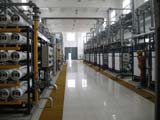
Case study: Optimizing RO
Ultrafiltration pretreatment works for NingBo Jiufeng co-generation facility

Industries needing great amounts of process water often rely on reverse osmosis (RO) treatment because it continuously provides high quality at a comparably lower cost. This treatment, however, requires sufficient feedwater pretreatment to prevent membrane fouling. Depending on the feedwater, pretreatment can be critical to ensuring a sustainable process.
The NingBo Jiufeng Co-gen Ltd. Co. produces heat and electricity for the NingBo province. The site also maintains a steady supply of steam and hot water, producing 270 tons per hour (t/h).
The factory's water treatment plants, one of which produces boiler make-up water, use the XiePu River for their source water. This presented a constantly changing challenge. The water treatment plant's intake is located near the estuary, which is subject to seawater intrusion from the changes in season, tides, and the weather. The Jiufeng water treatment plant water supply contains fluctuating salt levels, turbidity, and temperature. The river water averages 134.5 mg/L total suspended solids and 0.3 mg/L total iron. In addition, the temperature ranges from 64 to 77 degrees Fahrenheit on any given day.
With these conditions in mind, the plant designers looked for an economically viable solution for water pretreatment. Their top choices were conventional filters or a pretreatment method using ultrafiltration (UF).
Jiufeng designers decided to use Dow ™ SFP-2660 UF modules because
- At 60 inches in length, the module offers higher efficiencies over a wider range of feedwater conditions compared to some modules that are longer.
- Its unplasticized polyvinyl chloride housing eliminates the need for pressure vessels.
- Its 6-inch diameter is suitable for space-constrained installations.
- Its outside in-flow, double-walled hollow fiber configuration can be cleaned through simple backwashing and air scouring.
- The 0.03 µm-nominal pore diameter fibers also help reduce the need for additional pretreatment.
To treat the source water (see Figure 1), operators add 2 ppm of sodium hypochlorite (NaOCl) to oxidize iron and control biofouling. A heat exchanger adjusts the feedwater temperature and lessens the effect of temperature fluctuation on the UF and RO membranes. Operators add 5 ppm of sodium bisulfite (NaHSO3) to remove any residual oxidizing agent. Next, operators add 3 ppm of an antiscalant to protect the RO membrane. Following the RO unit, a decarbonator removes excess carbon dioxide from the water. The mixed bed removes hardness, charged ions, and chloride ions to produce high purity water. Finally, operators add 1 to 2 ppm of ammonia (NH3) to adjust pH for boiler make-up supply.
Since start-up in August 2005, pretreatment performance has been satisfactory. The product water turbidity averages 0.1 nephelometric turbidity units (NTU), at less than 0.2 NTU 90 percent of the time (Figure 2). Only once since start-up has the water turbidity been close to 0.4 NTU, which was due to the sudden discharge of foulant by an upstream factory during this period. The silt density index (SDI) has remained at = 2. Not a single Chemically Enhanced Backwash (CEB) has been needed over the last 43 months.
Once every six months, Jiufeng operators performed a Clean-In-Place (CIP) to restore the UF membranes' initial performance. The transmembrane pressure (TMP) dropped to less than 0.3 bar or approximately 5 psi right after each CIP and remained relatively constant over the following six months (Table 3). The flow pressure index (FPI; calculated as the skid’s permeate flow, m3/h, divided by TMP, bar), was restored to its initial value after each CIP (Table 4).
Reverse osmosis usually requires feed SDI(15) less than 5, however, in this case, the UF permeate SDI(15) was less than 2 and turbidity was less than 2.0 NTU (90 percent). The UF pretreatment provided very good quality RO feedwater, enabling optimal flux and high recovery of Jiufeng's RO membranes, which are Dow FILMTEC™ BW30-400 membranes.
So far, plant operators have cleaned the RO membranes four times. Typical cleaning frequency for RO membranes is every three to six months. Fewer cleanings mean less downtime of the RO unit as well as lower costs for cleaning chemicals.
Jiufeng Co-Gen is a solid example of how using UF pretreatment for RO membranes is an economically viable. In this case, six percent of the cost could be saved by ultrafiltration as compared to conventional pretreatment. This solution is sustainable for industries with large process water demand, even when the supply water presents challenges and the need for a reduced footprint is critical.
About the Author
Eric Shao is a marketing development specialist for Dow Water Solutions, based in China. He focuses on the engineering application and new technical application and marketing development study of ultrafiltration, electrodeionization and membrane bioreactor membranes applied in municipal, power, metallurgy, microelectronic, petrochemical, and dyeing industries.